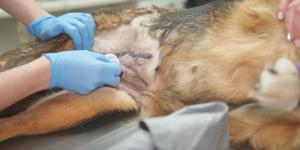Perineal Hernias in Dogs - Symptoms, Causes, Diagnosis, Treatment



See files for Dogs
Perineal hernias in dogs are not very common, however, if noticed, they do require immediate attention. If not treated in time, perineal hernias in dogs can lead to further complications which can put a dog’s life at risk.
For more about the symptoms, causes, diagnosis, home remedies and treatment of perineal hernias in dogs, keep reading here at AnimalWised.
What is a perineal hernia?
Perineal hernias in dogs refers to a protrusion in the anal area that may appear over time. Its presence can weaken the musculature structure of this sensitive area, resulting in difficulty when eliminating feces. In addition, these such dog hernias may increase in size through effort made when defecating.
This type of hernia in dogs is more common in older male dogs (7-10 years) that have not yet been sterilized. Due to the fact that female dogs they give birth, they naturally carry a stronger anal musculature which explains why they are more resistant to these such hernias. Dog breeds such as boxers, Border Collies and Pekingese are more prone to suffering from perineal hernias.
Perineal hernias in dogs can be unilateral or bilateral and usually contains contents such as fat, serous fluid, a dilated rectum, prostate, urinary bladder and/or the small intestine. Treatment for perineal hernias in dogs are complex and require surgery, however, recurrence is high.
Perineal hernias in dogs: causes
The exact cause of perineal hernias in dogs is unknown, although many believe it is related to hormonal imbalances, pressure after prostate enlargement or rectal diseases. Virtually any pathology capable of forcing additional pressure to the pelvic area could cause a hernia.
For more, we recommend reading our article where we discuss everything you need to know about a dog’s anal glands.

Perineal hernias in dogs: symptoms
The most common symptom of perineal hernias in dogs is a visible lump on either one or both sides of a dog’s anus. These types of hernias can also affect a dog’s urine circulation, which may explain why your dog may have difficulty urinating.
Symptoms will vary depending on the content of the hernia and may include:
- Constipation
- Difficulty defecating
- Urinary incontinence
- Abdominal pain
- Abnormal tail positioning
The presence of organs trapped in hernias can be fatal. Any type of perineal hernia in dogs requires immediate veterinary attention. Additionally, these symptoms are similar to those of periana fistula in dogs, and therefore, need to be distinguished by a veterinarian.
Inguinal hernia in dogs
It is important to recognize the difference between an inguinal hernia in dogs, which is located in the abdominal area, and perineal hernias, which are located in the anal area.
For more, read about inguinal hernia in dogs.
Perineal hernias in dogs: diagnosis
Diagnosis can only be done by a veterinarian and generally requires a rectal examination. In some cases, depending on the size and pain cause by the hernia, it may be necessary to sedate the animal. Blood tests, urine tests, ultrasounds and radiographs may also be required when diagnosing a perineal hernia in dogs.

Perineal hernias in dogs: treatment
Do perineal hernias go away? It depends. First and foremost, perineal hernias in dog treatment requires surgery. This surgery is complex and reconstruction surgery of this weakened area may be required. Perineal hernia reconstruction surgery usually entails moving grafts from different muscles to the anal area. In some instances, a veterinarian may opt for synthetic meshes instead. In a number of cases, in addition to a reduction of the hernia, castration is recommended.
Dog hernia recovery surgery
During the post-operative period, one must ensure that the dog is able to urinate and defecate correctly. If you notice that your dog is struggling with either of these, consult your veterinarian.
Analgesics and antibiotics should be administered, in addition to daily incision cleaning. Food also plays an incredibly important role in a dog hernia surgery recovery, as a dog’s diet is its main source of fiber. You will also need to keep your dog from licking or biting the incision, opt for an Elizabethan collar to achieve this. Lastly, make sure that your dog’s exercise intensity is controlled as rest is key for a full recovery. It’s important to know that hernia recurrence is, unfortunately, quite common.
Because perineal hernias are more common in older dogs, the risks of such an intense surgery are not recommended. In these such cases, a veterinarian would likely opt for alternative measures. These will not, however, cure the hernia. Alternative anal hernia in dog treatment may include enemas, stool softeners, fluid therapy, analgesia and an proper diet.
Dog perineal hernia: home remedies
There are no home remedies for this type of hernia in dogs. In cases that the hernia cannot be operated on, we recommend following veterinary recommendations, specifically in terms of diet. It is essential that a dog suffering from perineal hernias, or post-op, makes no effort defecating. Therefore, under the guidance of your veterinarian, we recommend offering your dog a diet rich in fiber to soften its stools.
For more, we recommend reading our article where we discuss a soft diet for constipated dogs.

Perineal hernia dog: untreated
According to McCarthy, Lux and Seibert in ‘Perineal evisceration secondary to a bite injury in a dog with an untreated perineal hernia’ (2016) If perineal hernias in dogs are left untreated they,‘‘may predispose patients to catastrophic injury due to the proximity of abdominal organs to the skin if a traumatic episode were to occur[1].’’
Untreated perineal hernias in dogs can be extremely dangerous and/or even fatal if not treated in time.
This article is purely informative. AnimalWised does not have the authority to prescribe any veterinary treatment or create a diagnosis. We invite you to take your pet to the veterinarian if they are suffering from any condition or pain.
If you want to read similar articles to Perineal Hernias in Dogs - Symptoms, Causes, Diagnosis, Treatment, we recommend you visit our Other health problems category.
1. McCarthy D, Lux C, Seibert R, Perineal evisceration secondary to a bite injury in a dog with an untreated perineal hernia: NCBI. Can Vet J 2016, 57 (10): 1053-1056.
Bongartz A, Carofiglio F, Balligand M, Heimann M, Hamaide A. Uso de injertos autógenos de fascia lata para la reparación de hernias perineales en el perro. Vet Surg 2005, 34: 405-13.
Pratummintra K, Chuthatep S, Banlunara W, Kalpravidh M. Perineal Hernia Repair Using an Autologus Tunica Vaginalis Communis in Nine Intact Male Dogs. J Vet Med Sci. 2012 Nov 6.
Shaughnessy M, Monnet E. Transposición del músculo obturador interno como tratamiento de la hernia perineal en perros: 34 casos (1998-2012). J Am Vet Med Assoc 2015, 246: 321-326.









